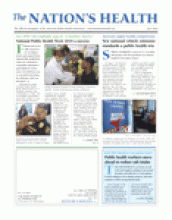Spring marked a victory for U.S. air quality with passage of the first greenhouse gas emission standards in the nation’s history.
On April 1, the Environmental Protection Agency and Department of Transportation issued finalized rules establishing new vehicle greenhouse gas emission and fuel economy standards starting with 2012 model-year vehicles. According to the agencies, the new rules will reduce carbon dioxide emissions by about 960 million metric tons over the lifetime of the affected vehicles and will be equivalent to taking 50 million cars and light trucks off the road by 2030.
“This is a significant step towards cleaner air and energy efficiency, and an important example of how our economic and environmental priorities go hand-in-hand,” said EPA Administrator Lisa Jackson. “By working together with industry and capitalizing on our capacity for innovation, we’ve developed a clean cars program that is a win for automakers and drivers, a win for innovators and entrepreneurs, and a win for our planet.”
The new rules come just a handful of months after EPA released its official finding that greenhouse gases pose a threat to the public health and welfare of the American people. The move also brings the federal government in line with efforts by California and 13 other states that had fought for years to more stringently regulate vehicle emissions as well as a 2007 Supreme Court decision affirming EPA’s authority to regulate greenhouse gases. As part of the agreement that led to the new emission standards, the states will defer to the federal rules through 2016, but will preserve the right to set stricter standards in the future.

A California resident gets an emissions test in May 2009. Federal agencies estimate that new vehicle greenhouse gas emission standards will significantly reduce carbon dioxide pollution.
Photo by Justin Sullivan, courtesy Getty Images
The rules apply to model-year 2012 through 2016 passenger cars and light trucks and are expected to improve fuel efficiency by about 5 percent annually and reduce greenhouse gas emissions by 21 percent by 2030. EPA and DOT calculated that the new fuel efficiency standards will save about 1.8 billion barrels of oil over the lifetimes of the affected vehicles.
“This change was long overdue,” said APHA member Jonathan Patz, MD, MPH, a professor of environmental studies and population health science at the University of Wisconsin–Madison and a co-author of several reports from the U.N. Intergovernmental Panel on Climate Change. “Transportation makes up about one-third of greenhouse gas emissions (in the United States), so if we really start improving efficiency, it will make a difference.”
A wealth of scientific studies have linked vehicle-related pollution to poor health outcomes, especially among children. One recent study, published April 22 in the American Journal of Respiratory and Critical Care Medicine and based on children ages 5 to 17 in Atlanta, found that vehicle emissions were linked to emergency department visits for asthma and wheezing. The study found that “even at relatively low ambient concentrations, ozone and primary pollutants from traffic sources independently contributed to the burden of emergency department visits for pediatric asthma.”
Such studies not only add fodder to the rationale for stricter vehicle standards, but to the growing call to diversify the nation’s transportation system to accommodate and encourage all modes of travel, such as biking and walking.
Americans want more transportation options
Fortunately, Americans overwhelmingly support better access to public transportation and safer places to walk and bike — options that have positive public health benefits via increased physical activity, reduced fatalities and injuries, and decreased pollution.
A survey released in March by Transportation for America found that 82 percent of American voters said the nation would “benefit from an expanded and improved transportation system, such as rail and buses.” In fact, three in five voters surveyed said they would choose improving public transportation and making it easier to walk and bike rather than building more roads. The majority of survey participants also supported increasing the federal funds that go toward public transportation.
“In small towns and big cities alike, Americans are saying loudly and clearly that their lives would be better, and their nation stronger, if we had world-class public transportation and more options for walking and bicycling,” said Geoff Anderson, co-chair of Transportation for America and president of Smart Growth America. “If Americans themselves were crafting the transportation bill, we would see a doubling of the share for public transportation…and a strong commitment to making all our streets safe enough for kids to bicycle to school or so seniors can walk to nearby restaurants or the drug store.”

A streetcar picks up passengers in November 2009 in San Francisco, home to one of the nation’s largest public transportation systems. A recent Transportation for America survey found a majority of Americans support improving public transit.
Photo by Chip Chipman/Bloomberg, courtesy Getty Images
Anderson is referring to the nation’s largest federal surface transportation bill, known as the Safe, Accountable, Flexible, Efficient Transportation Equity: A Legacy for Users bill — also known as SAFETEA-LU. Originally signed into law in 2005, the bill is now before Congress for reauthorization, which means policy-makers have an opportunity to increase the amount of funds that support public safety efforts and public transit as well as biking and walking.
David Goldberg, communications director at Transportation for America, noted that due to the crowded legislative agenda now before Congress, it may be unlikely that the transportation bill makes it to the president’s desk this summer. However, “every day that goes by we have a stronger coalition and larger grassroots network across the country and it becomes clearer to us that major reform is a real possibility,” he said.
“The stars really seem aligned for some meaningful reform that could have tremendous implications for how Americans will get around in the future, the level of safe and healthy exercise they get, and the overall health of communities,” Goldberg told The Nation’s Health.
With the connections between community well-being and transportation growing stronger every day, public health advocates, such as APHA and the Centers for Disease Control and Prevention, are busy making the case for health-friendly and equitable transportation policies. In April, CDC released its recommendations for improving health via transportation policy, calling for expanding public transportation, promoting active transportation, such as biking, and encouraging community designs that protect residents from traffic pollution and reduce pedestrian injury and death.
A new report from APHA, the “Hidden Health Costs of Transportation,” notes that despite the wealth of evidence, “health impacts and costs have typically not been considered in the transportation policy, planning and funding decision-making process.” For example, the report references a physical activity study finding that more walkable urban designs would not only encourage more physical activity, but save health care dollars.
“Our system of transportation investment has resulted in many benefits for the United States and its residents, but today’s growing, aging and urbanizing population has different needs and expectations for a transportation system,” the report stated.
For a copy of the APHA report, visit www.apha.org/advocacy/reports/reports. For more information on the nation’s new vehicle emissions and fuel economy standards, visit www.epa.gov.
- Copyright The Nation’s Health, American Public Health Association









